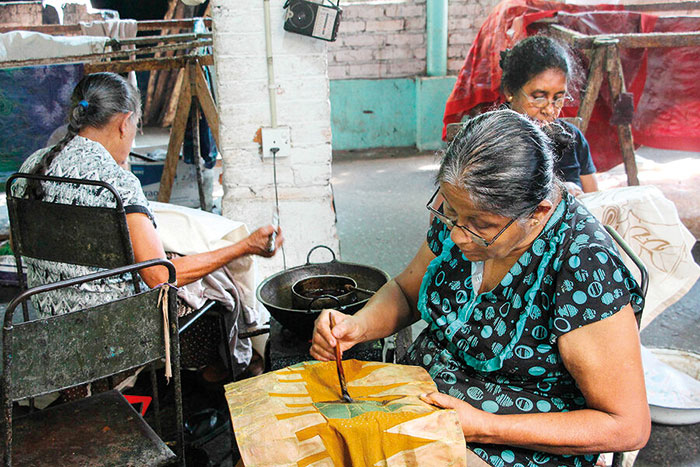How Sri Lanka’s batik artists keep the craft alive
By Zinara Rathnayake
Jezima Mohammed has run a small workshop and boutique, Jez Look Batiks, from her home in Matara, Sri Lanka, for nearly seven decades. Now in her 80s, she still works every day. When visitors stop by, the batik artist proudly shows off framed letters from Buckingham Palace and a photo of Queen Elizabeth II sporting a white satin scarf with baby pink florals – one of her designs. Meanwhile, outside, a group of artisans meticulously outline peacock motifs onto off-white fabric with boiling hot wax.
“They are my girls,” she says of the 16 women currently employed by her shop, “and we work like a family.”
It’s often said that batik came to Sri Lanka from Indonesia, where the art form is recognized by UNESCO as an important part of humanity’s intangible heritage, but late researcher Gerret Pieter Rouffaer believed it was India or Sri Lanka that introduced the resist dyeing technique to the Indonesian islands.
Murky origins aside, batik flourished in Sri Lanka during the 1960s, with female artists like Ena de Silva creating massive tapestries that adorned the ceilings of Colombo’s most iconic buildings. Small businesses such as Ms. Mohammed’s shop emerged to meet the demand for the popular medium. Then, in 1983, civil war brought the industry to an abrupt halt.

One of 16 female artisans working at Ms. Mohammed’s home batik workshop in Matara, Sri Lanka, focuses on preparing a new design “We work like a family,” says Ms. Mohammed.
It never fully recovered, say artists and historians. Today, lingering impacts of pandemic lockdowns and record-high inflation make it difficult for cottage artisans to afford supplies, while waning interest in batik apprenticeship threatens the beleaguered art form’s future. Still, batik continues to endure thanks to passionate artists across the island. In fact, industry veterans such Ms. Mohammed say that decades of war and other hardships have helped prepare them for modern challenges.
“One thing is certain,” she says. “You have to keep going. You can’t stop your work. If you do, batik will stop.”
Careers defined by perseverance
Before the Sri Lankan Civil War, Ms. Mohammed’s workshop brimmed with curious outsiders wanting to learn about batik. “One traveler who came here mentioned me in an old guidebook, so everyday there was someone. Tourists loved it,” Ms. Mohammed says.
Making a batik garment starts with drawing the design on paper and planning out each colour. Using a copper stylus and a mix of hot paraffin and beeswax, an artisan then outlines the pattern onto both sides of a natural, white fabric, which is then immersed in dye, starting with the lightest color.
After the pigment sinks in, the artist can remove the wax with boiling water and move onto the next element of the design, repeating this process of waxing, dyeing, and boiling until the pattern is complete. The finished cloth is washed with soap and sun-dried before it’s sewn into kimonos or other garments. Ms. Mohammed also designed bedding, curtains, and staff uniforms for popular seaside hotels.

Colourful batik designs fill the entrance of artist Gnana Prabha Ranasinghe’s home, which has been converted into a small boutique in Galle, Sri Lanka. Ranasinghe is one of the island’s few male batik designers

A batik artist outlines a design using hot wax, a key step in the resist dyeing technique. The finished cloth is washed with soap and sun-dried before its sewn into kimonos or other garments.
“It was a very bright, happy time,” she says. “Then the war started.”
As long standing ethnoreligious tensions erupted into violence across the island, those curious outsiders dwindled, but thanks to her now-international reputation for popular, fashionable garments, Ms. Mohammed was able to maintain a niche market for her designs. Former visitors and hotel owners continued to order new prints, and she was also invited to overseas workshops and exhibitions.
Still, times were tough, and she often found herself relying on the generosity of others.
“I met many kindhearted people who helped me a lot. When business was slow, my sons gave me small loans to pay my girls,” Ms. Mohammed says.
During lockdowns, she bore that lesson of community in mind, allowing her fellow artisans to work whenever they could and making sure they always had dry rations. “We are a team, and we have to look after each other,” Ms. Mohammed says.
Nowadays, Sri Lanka’s cost-of-living crisis makes it difficult to afford kerosene oil, Ms. Mohammed says. She goes out daily to buy dried coconut shells as an alternative fuel for her artisans’ wax burners.
It’s a devotion shared by other batik veterans, such as Gnana Prabha Ranasinghe, who resides in the southern city Galle and is one of Sri Lanka’s few male batik designers. Like many Sri Lankan crafts, batik is widely seen as a job for women, but Mr. Ranasinghe was eager to inherit his family’s home-based workshop in the 1970s.
Christian Science Monitor



